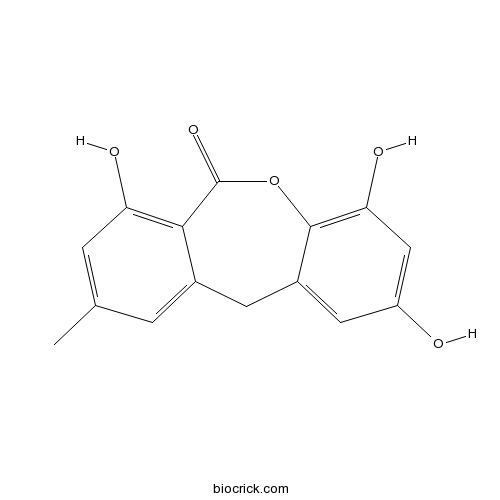9-DehydroxyeurotinoneCAS# 1360606-85-4 |

Quality Control & MSDS
3D structure
Package In Stock
Number of papers citing our products

| Cas No. | 1360606-85-4 | SDF | Download SDF |
| PubChem ID | 56837424 | Appearance | Powder |
| Formula | C15H12O5 | M.Wt | 272.25 |
| Type of Compound | Phenols | Storage | Desiccate at -20°C |
| Solubility | Soluble in Chloroform,Dichloromethane,Ethyl Acetate,DMSO,Acetone,etc. | ||
| Chemical Name | 2,4,7-trihydroxy-9-methyl-11H-benzo[c][1]benzoxepin-6-one | ||
| SMILES | CC1=CC(=C2C(=C1)CC3=CC(=CC(=C3OC2=O)O)O)O | ||
| Standard InChIKey | JVEWVOQVOXHEQA-UHFFFAOYSA-N | ||
| Standard InChI | InChI=1S/C15H12O5/c1-7-2-8-4-9-5-10(16)6-12(18)14(9)20-15(19)13(8)11(17)3-7/h2-3,5-6,16-18H,4H2,1H3 | ||
| General tips | For obtaining a higher solubility , please warm the tube at 37 ℃ and shake it in the ultrasonic bath for a while.Stock solution can be stored below -20℃ for several months. We recommend that you prepare and use the solution on the same day. However, if the test schedule requires, the stock solutions can be prepared in advance, and the stock solution must be sealed and stored below -20℃. In general, the stock solution can be kept for several months. Before use, we recommend that you leave the vial at room temperature for at least an hour before opening it. |
||
| About Packaging | 1. The packaging of the product may be reversed during transportation, cause the high purity compounds to adhere to the neck or cap of the vial.Take the vail out of its packaging and shake gently until the compounds fall to the bottom of the vial. 2. For liquid products, please centrifuge at 500xg to gather the liquid to the bottom of the vial. 3. Try to avoid loss or contamination during the experiment. |
||
| Shipping Condition | Packaging according to customer requirements(5mg, 10mg, 20mg and more). Ship via FedEx, DHL, UPS, EMS or other couriers with RT, or blue ice upon request. | ||
| Structure Identification | Helvetica Chimica Acta, 2012, 95(1):163-168.Alkaloid and Anthraquinone Derivatives Produced by the Marine-Derived Endophytic Fungus Eurotium rubrum.[Reference: WebLink]
|

9-Dehydroxyeurotinone Dilution Calculator

9-Dehydroxyeurotinone Molarity Calculator
| 1 mg | 5 mg | 10 mg | 20 mg | 25 mg | |
| 1 mM | 3.6731 mL | 18.3655 mL | 36.7309 mL | 73.4619 mL | 91.8274 mL |
| 5 mM | 0.7346 mL | 3.6731 mL | 7.3462 mL | 14.6924 mL | 18.3655 mL |
| 10 mM | 0.3673 mL | 1.8365 mL | 3.6731 mL | 7.3462 mL | 9.1827 mL |
| 50 mM | 0.0735 mL | 0.3673 mL | 0.7346 mL | 1.4692 mL | 1.8365 mL |
| 100 mM | 0.0367 mL | 0.1837 mL | 0.3673 mL | 0.7346 mL | 0.9183 mL |
| * Note: If you are in the process of experiment, it's necessary to make the dilution ratios of the samples. The dilution data above is only for reference. Normally, it's can get a better solubility within lower of Concentrations. | |||||

Calcutta University

University of Minnesota

University of Maryland School of Medicine

University of Illinois at Chicago

The Ohio State University

University of Zurich

Harvard University

Colorado State University

Auburn University

Yale University

Worcester Polytechnic Institute

Washington State University

Stanford University

University of Leipzig

Universidade da Beira Interior

The Institute of Cancer Research

Heidelberg University

University of Amsterdam

University of Auckland

TsingHua University

The University of Michigan

Miami University

DRURY University

Jilin University

Fudan University

Wuhan University

Sun Yat-sen University

Universite de Paris

Deemed University

Auckland University

The University of Tokyo

Korea University
- Desrhamnosylmartynoside
Catalog No.:BCN7648
CAS No.:136055-64-6
- [D-Lys3]-GHRP-6
Catalog No.:BCC5850
CAS No.:136054-22-3
- Justiciresinol
Catalog No.:BCN3419
CAS No.:136051-41-7
- Fmoc-Cys(pMeBzl)-OH
Catalog No.:BCC3476
CAS No.:136050-67-4
- Schisanlactone E
Catalog No.:BCN2593
CAS No.:136040-43-2
- Fmoc-Tic-OH
Catalog No.:BCC3341
CAS No.:136030-33-6
- (1R,2S)-1-Amino-2-indanol
Catalog No.:BCC8381
CAS No.:136030-00-7
- Angiotensin III (human, mouse)
Catalog No.:BCC1031
CAS No.:13602-53-4
- AVL-292 benzenesulfonate
Catalog No.:BCC1386
CAS No.:1360053-81-1
- Ranaconitine
Catalog No.:BCN3870
CAS No.:1360-76-5
- Tetracaine HCl
Catalog No.:BCC4399
CAS No.:136-47-0
- Phenazopyridine HCl
Catalog No.:BCC4698
CAS No.:136-40-3
- Necrosulfonamide
Catalog No.:BCC7992
CAS No.:1360614-48-7
- 5-Methoxyisolariciresinol
Catalog No.:BCN7016
CAS No.:136082-41-2
- Onjixanthone II
Catalog No.:BCN7559
CAS No.:136083-93-7
- Lobetyolin
Catalog No.:BCN5894
CAS No.:136085-37-5
- Isomucronulatol 7-O-beta-glucoside
Catalog No.:BCN8088
CAS No.:136087-29-1
- 14-Dehydrodelcosine
Catalog No.:BCN8119
CAS No.:1361-18-8
- LDC1267
Catalog No.:BCC5577
CAS No.:1361030-48-9
- Przewalskinic acid A
Catalog No.:BCN2925
CAS No.:136112-75-9
- 3,7-Di-O-methylducheside A
Catalog No.:BCN6191
CAS No.:136133-08-9
- Minocycline HCl
Catalog No.:BCC4679
CAS No.:13614-98-7
- (S)-(+)-Dimethindene maleate
Catalog No.:BCC7061
CAS No.:136152-65-3
- E3330
Catalog No.:BCC6421
CAS No.:136164-66-4
Natural anthraquinone derivatives from a marine mangrove plant-derived endophytic fungus Eurotium rubrum: structural elucidation and DPPH radical scavenging activity.[Pubmed:19652514]
J Microbiol Biotechnol. 2009 Jul;19(7):675-80.
There is considerable interest in the isolation of potent radical scavenging compounds from natural resources to treat diseases involving oxidative stress. In this report, four new fungal metabolites including one new bisdihydroanthracenone derivative (1, eurorubrin), two new seco-anthraquinone derivatives [3, 2-O-methyl-9-Dehydroxyeurotinone and 4, 2-Omethyl- 4-O-(alpha-D-ribofuranosyl)-9-Dehydroxyeurotinone], and one new anthraquinone glycoside [6, 3-O-(alpha-D-ribofuranosyl)- questin], were isolated and identified from Eurotium rubrum, an endophytic fungal strain that was isolated from the inner tissue of the stem of the marine mangrove plant Hibiscus tiliaceus. In addition, three known compounds including asperflavin (2), 2-O-methyleurotinone (5), and questin (7) were also isolated and identified. Their structures were elucidated on the basis of spectroscopic analysis. All of the isolated compounds were evaluated for 1,1-diphenyl-2-picrylhydrazyl(DPPH) radical scavenging activity.


